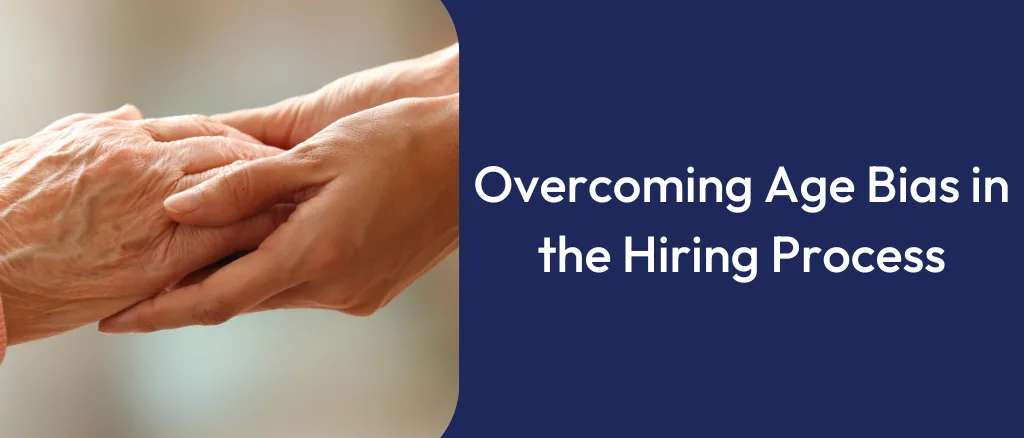Age bias, or ageism, remains a significant challenge in the hiring process, impacting job seekers, employers, and society. Despite progress in workplace diversity and inclusion efforts, older professionals frequently face unspoken barriers when seeking opportunities.
A 2022 study by AARP revealed that approximately 61% of workers over the age of 45 have experienced or witnessed age-based discrimination in the workplace. This bias doesn’t just harm individuals—it also deprives businesses of experienced talent while perpetuating economic inequality.
This post dives into the impact of ageism, offers strategies for job seekers to overcome it, and provides guidelines for organisations to combat age bias and foster genuinely inclusive workplaces.
Understanding The Impact Of Ageism
Ageism On Individuals
For professionals over the age of 45 or 50, age bias can mean fewer opportunities, longer periods of unemployment, and the stigma of being “overqualified” or “outdated.” These misconceptions often force highly skilled workers into roles that don’t reflect their capabilities or experience.
The emotional toll of ageism cannot be understated—it undermines self-worth and confidence, making it even harder for individuals to present their best selves during job applications or interviews.
Ageism And The Workforce
When organisations undervalue older workers, they miss out on a wealth of knowledge, institutional memory, and training potential. Older professionals are more likely to display loyalty and resilience, qualities which can dramatically improve employee retention rates across the board.
Age diversity also improves team performance. Multi-generational workforces benefit from combining fresh perspectives with seasoned expertise, fostering innovation and well-rounded decision-making.
Ageism And The Economy
Excluding older workers from the job market affects entire economies. The Organisation for Economic Co-operation and Development (OECD) estimates that bringing more older workers into employment could significantly boost GDP for ageing populations. After all, a more diverse workforce drives productivity and reduces dependency on social services.
Strategies For Job Seekers To Overcome Age Bias
While the fight against ageism requires systemic change, individuals can still take proactive steps to mitigate its impact during the hiring process.
Refresh Your CV And LinkedIn Profile
- Highlight recent achievements instead of listing all roles spanning decades. Focus on positions from the last 10–15 years while emphasising transferable skills and measurable successes.
- Update your LinkedIn profile to show you’re proficient in digital platforms. A well-maintained profile demonstrates ongoing engagement with industry trends and debunks false assumptions about being “digitally inept.”
Tailor Your Appearance For Interviews
Present yourself as professional and adaptable. Consider updating your style to current trends without altogether abandoning your aesthetics. A polished look can help convey competence and adaptability amidst apparent surface-level judgments.
Stay Technologically Fluent
- Knowledge of tools like Slack, Monday.com, and Zoom signals to employers that you’re ready for a digital-first workplace.
- FREE courses on Coursera or LinkedIn Learning can improve your skills and provide certifications to strengthen your CV.
Build And Maintain A Network
Often, word-of-mouth recommendations override preconceived biases. Attend industry conferences, join professional networking groups, and maintain relationships with former colleagues who may know of job openings that aren’t widely advertised.
Look Into Retraining Opportunities
Upskilling is an excellent way to demonstrate initiative and adaptability. Consider certifications in digital marketing, IT, cybersecurity, or project management—fields that offer growing industry opportunities. Many non-profits and government initiatives provide financial support for retraining mid-career professionals.
Best Practices For Employers To Combat Age Bias
Creating a workplace that values diversity requires meaningful hiring practices and culture changes. Here’s how businesses can foster inclusivity for employees of all ages.
Recognise Unconscious Bias
Every organisation should provide mandatory unconscious bias training that includes a focus on ageism. This helps hiring managers identify subconscious tendencies, like favouring younger applicants even when more experienced professionals may be better suited for the role.
Use Inclusive Wording In Job Descriptions
Phrases like “seeking digital natives” or “energetic team players” imply favouritism towards younger applicants. Revise descriptions to focus on skills and competencies rather than implied demographics.
Focus On Skills-Based Hiring
Rather than evaluating candidates purely for their previous roles or length of experience, prioritise skillsets and proof of their ability to deliver results. This reduces subjective judgments that may unfairly limit older professionals.
Foster An Age-Inclusive Culture
- Mentorship programmes that pair older employees with younger ones can encourage knowledge sharing, bridging generational gaps while fostering respect.
- Promote cross-generational collaboration where team initiatives encourage employees of different ages to work towards common goals.
Ensure Equal Learning Opportunities
Offer professional development opportunities that cater to employees across all ages. Whether it’s leadership development programmes or skill refreshers, access should not depend on age-based assumptions.
Measure And Adjust Recruitment Practices
Regularly review analytics from your hiring process. Are more young candidates advancing to the interview stages compared to seasoned applicants? Identify areas where bias may unintentionally creep in and adjust accordingly.
Why Age Diversity Matters For Business Success
Age diversity isn’t merely a checkbox—it’s an essential component of organisational success in an increasingly complex world. True workplace inclusion doesn’t categorise employees based on generational stereotypes but sees value in everyone’s unique perspective and skillset.
By actively reducing age bias, supporting retraining efforts, and enhancing inclusive recruitment strategies, businesses can build teams that are not only more diverse but also more innovative, collaborative, and future-ready.
Remember: Inclusivity isn’t just the right thing to do—it’s also a smart business strategy.
Take Action Today
Whether you’re navigating age barriers as a job seeker or reshaping your organisation’s approach to hiring, there’s always room for improvement. Start closing the age gap by fostering understanding and taking steps towards creating equal opportunities for every professional, regardless of age.
Contact our Team of Recruitment Experts
If you are looking for a recruitment agency that can provide you with the highest quality candidates, including in the commercial sector, look no further than Pure Staff. Contact us today to learn more about our services and how we can help you find a suitable candidate for your business.



